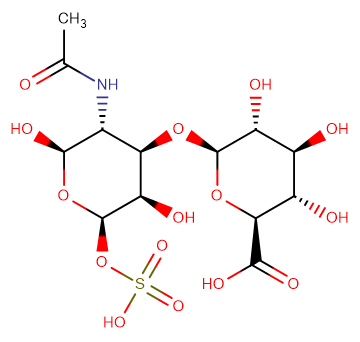
Chondroitine sulfate
CAS No. 9007-28-7
Chondroitine sulfate( —— )
Catalog No. M16476 CAS No. 9007-28-7
Extracted from shark bone.
Purity : >98% (HPLC)
 COA
COA
 Datasheet
Datasheet
 HNMR
HNMR
 HPLC
HPLC
 MSDS
MSDS
 Handing Instructions
Handing Instructions
| Size | Price / USD | Stock | Quantity |
| 100MG | 29 | Get Quote |


|
| 1G | 61 | Get Quote |


|
Biological Information
-
Product NameChondroitine sulfate
-
NoteResearch use only, not for human use.
-
Brief DescriptionExtracted from shark bone.
-
DescriptionExtracted from shark bone;Store the product in sealed, cool and dry condition.(In Vitro):Chondroitin sulfate is a class of sulfated glycosaminoglycans that are linear polysaccharides consisting of repeating disaccharide units composed of uronic acid and N-acetylhexosamine. Several pathogens including parasites, bacteria, and viruses have been shown to utilize cell surface chondroitin sulfate chains to attach to and infect host cells. Chondroitin sulfate occurs naturally in the extracellular matrix of connective tissues, e.g., bone, cartilage, skin, ligaments and tendons. Chondroitin sulfate has been shown to elicit a range of beneficial effects: anti-inflammatory effects, an increase in type II collagen and proteoglycans, a reduction in bone resorption and a better anabolic/catabolic balance in chondrocytes. A large range of chondroitin sulfate concentrations has been used (e.g. 12.5 to 2000 mg/mL, but generally less than200 mg/mL) in in vitro studies. Chondroitin sulfate (200 mg/mL) decreases the chondrocyte susceptibility to single nucleotide polymorphism-induced apoptosis. Chondroitin sulfate reduces inflammation mediators and the apoptotic process and is able to reduce protein production of inflammatory cytokines, iNOS, MMPs. (In Vivo):The high content of chondroitin sulfate in the aggrecan plays a major part in allowing cartilage to resist tensile stresses during various loading conditions by providing this tissue with resistance and elasticity. It has been shown that chondroitin sulphate interferes with the progression of structural changes in joint tissues and is used in the management of patients with osteoarthritis. Chondroitin sulfate is mostly administered orally at doses ranging from 800 to 1200mg/day. Chondroitin sulfate is rapidly absorbed by the gastrointestinal tract. The absorbed chondroitin sulfate reaches the blood compartment as 10% chondroitin sulfate and 90% depolymerized low-molecular-weight derivatives.
-
In VitroChondroitin sulfate is a class of sulfated glycosaminoglycans that are linear polysaccharides consisting of repeating disaccharide units composed of uronic acid and N-acetylhexosamine. Several pathogens including parasites, bacteria, and viruses have been shown to utilize cell surface chondroitin sulfate chains to attach to and infect host cells. Chondroitin sulfate occurs naturally in the extracellular matrix of connective tissues, e.g., bone, cartilage, skin, ligaments and tendons. Chondroitin sulfate has been shown to elicit a range of beneficial effects: anti-inflammatory effects, an increase in type II collagen and proteoglycans, a reduction in bone resorption and a better anabolic/catabolic balance in chondrocytes. A large range of chondroitin sulfate concentrations has been used (e.g. 12.5 to 2000 mg/mL, but generally less than200 mg/mL) in in vitro studies. Chondroitin sulfate (200 mg/mL) decreases the chondrocyte susceptibility to single nucleotide polymorphism-induced apoptosis. Chondroitin sulfate reduces inflammation mediators and the apoptotic process and is able to reduce protein production of inflammatory cytokines, iNOS, MMPs.
-
In VivoThe high content of chondroitin sulfate in the aggrecan plays a major part in allowing cartilage to resist tensile stresses during various loading conditions by providing this tissue with resistance and elasticity. It has been shown that chondroitin sulphate interferes with the progression of structural changes in joint tissues and is used in the management of patients with osteoarthritis. Chondroitin sulfate is mostly administered orally at doses ranging from 800 to 1200mg/day. Chondroitin sulfate is rapidly absorbed by the gastrointestinal tract. The absorbed chondroitin sulfate reaches the blood compartment as 10% chondroitin sulfate and 90% depolymerized low-molecular-weight derivatives.
-
Synonyms——
-
PathwayOthers
-
TargetOther Targets
-
RecptorOthers
-
Research Area——
-
Indication——
Chemical Information
-
CAS Number9007-28-7
-
Formula Weight463.37
-
Molecular FormulaC13H21NO15S
-
Purity>98% (HPLC)
-
SolubilityDMSO: 10 mM
-
SMILESCC(=O)N[C@@H]1[C@H]([C@H]([C@H](O[C@H]1O)OS(=O)(=O)O)O)O[C@H]2[C@@H]([C@H]([C@@H]([C@H](O2)C(=O)O)O)O)O
-
Chemical Name——
Shipping & Storage Information
-
Storage(-20℃)
-
ShippingWith Ice Pack
-
Stability≥ 2 years
Reference
1.Kakizaki I, et al.Carbohydr Polym. 2015 May 5;121:362-7
molnova catalog



related products
-
Probimane
Probimane had Anti-proliferative effects, cell cycle G2/M phase arrest and blocking of chromosome segregation in human tumor cell lines with MST-16.
-
Odonicin
Odonicin is a kind of natural product derived from the herbs of Rabdosia longituba.
-
Nithiamide
Nithiamide is a non-5-nitroimidazole drugs.



 Cart
Cart
 sales@molnova.com
sales@molnova.com


